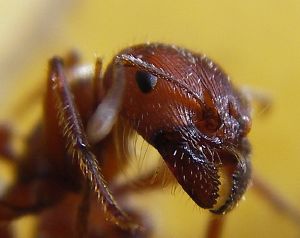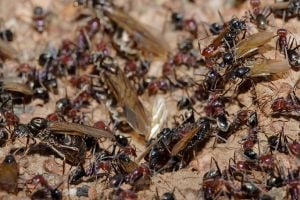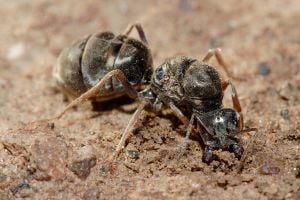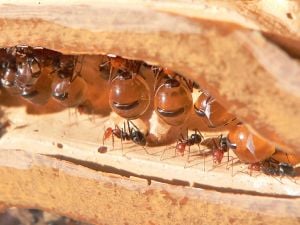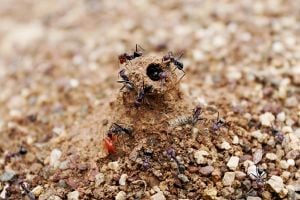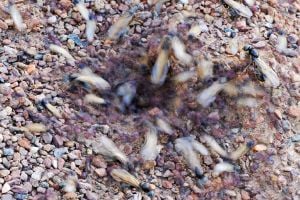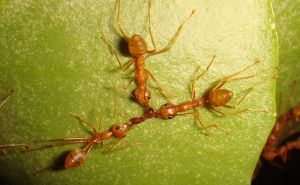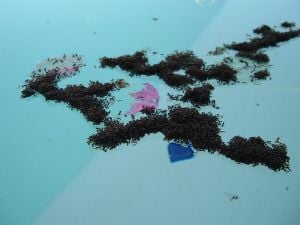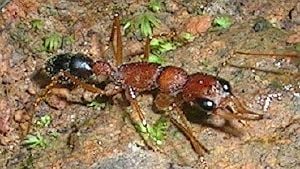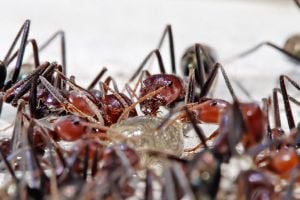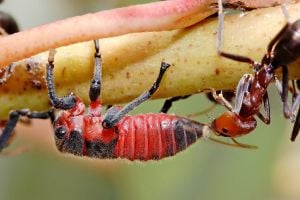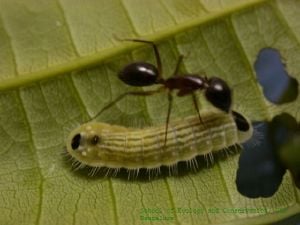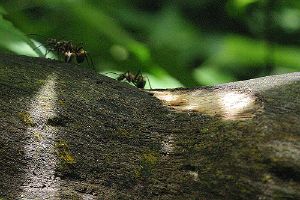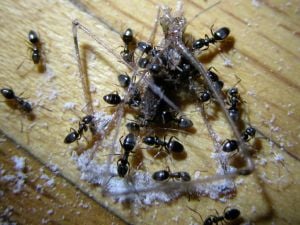Difference between revisions of "Ant" - New World Encyclopedia
| Line 37: | Line 37: | ||
}} | }} | ||
| − | '''Ants''' are [[insect]]s of the family '''Formicidae''' | + | '''Ants''' are [[insect]]s of the family '''Formicidae'''. They, along with the related families of [[wasp]]s and [[bee]]s, belong to the order [[Hymenoptera]]. Ants are the one of the world's most successful and diverse [[animal]] families, with more than 12,000 [[species]]. They are [[eusocial]] and known for their highly organized [[colony (biology)|colonies]] and nests, which sometimes consist of millions of individuals. Individuals are divided into sub-fertile, and more commonly sterile, females ("workers"), fertile males ("drones"), and fertile females ("queens"). Colonies can occupy and use a wide area of land to support themselves. Ant colonies are sometimes described as superorganisms because the colony appears to operate as a unified entity. |
Ants are found on almost every landmass on [[Earth]]. The only places lacking indigenous ant species are [[Antarctica]], [[Greenland]], [[Iceland]], parts of [[Polynesia]], the [[Hawaii|Hawaiian Islands]], and some other remote islands. When all their individual contributions are added up, they may constitute up to 15 to 25 percent of the total terrestrial animal [[biomass (ecology)|biomass]]. (Jones 2007, Krushelnycky 2005, Schultz 2000). | Ants are found on almost every landmass on [[Earth]]. The only places lacking indigenous ant species are [[Antarctica]], [[Greenland]], [[Iceland]], parts of [[Polynesia]], the [[Hawaii|Hawaiian Islands]], and some other remote islands. When all their individual contributions are added up, they may constitute up to 15 to 25 percent of the total terrestrial animal [[biomass (ecology)|biomass]]. (Jones 2007, Krushelnycky 2005, Schultz 2000). | ||
| Line 92: | Line 92: | ||
===Defense=== | ===Defense=== | ||
| − | [[Image:WeaverAntDefense.JPG|thumb|A | + | [[Image:WeaverAntDefense.JPG|thumb|A weaver ant in fighting position, [[mandible]]s wide open]] |
[[Image:WeaverAntsAgainstRedAnt.JPG|thumb|Weaver ants collaborating to dismember a red ant (the two at the extremities are pulling the red ant, while the middle one cuts the red ant until she snaps)]] | [[Image:WeaverAntsAgainstRedAnt.JPG|thumb|Weaver ants collaborating to dismember a red ant (the two at the extremities are pulling the red ant, while the middle one cuts the red ant until she snaps)]] | ||
| − | Ants attack others and defend themselves by biting and in many species, stinging, often injecting chemicals like [[formic acid]]. | + | Ants attack others and defend themselves by biting and in many species, stinging, often injecting chemicals like [[formic acid]]. Bullet ants (the genus ''Paraponera''), found in [[Central America|Central]] and [[South America]], are considered to have the most painful sting among insects, although these are usually non-fatal. They are given the highest rating on the Schmidt Sting Pain Index. Jack jumper ants, ''Myrmecia pilosula'', found in Australia have stings that cause fatality to a small number of people in the population, and cause hospitalizations each year (Clarke 1986). A vaccine based on use of the venom extract to develop immunity has been developed (Brown 2005). |
| − | [[ | + | Some ants of the genus ''Odontomachus'' are equipped with mandibles called trap-jaws. This snap-jaw mechanism, or catapult mechanism, is possible because energy is stored in the large closing muscles. The blow is incredibly fast, about 0.5 [[millisecond|ms]] in the genus ''Mystrium''. Before the strike, the mandibles open wide and are locked in the open position by the labrum, which functions as a latch. The attack is triggered by stimulation of sensory hairs at the side of the mandibles. The mandibles are also able to function as a tool for more finely adjusted tasks. Two similar groups are ''Odontomachus'' and ''Dacetini'' - examples of [[convergent evolution]]. |
| − | + | Apart from defense against larger threats, ants also need to defend their colonies against disease organisms. Some ant workers' role is to maintain the hygiene of the colony and their activities include undertaking or necrophory, the transport of dead nest-mates.<ref>{{cite journal|quotes=no|author=Julian G.E., Cahan S. |title=Undertaking specialization in the desert leaf-cutter ant ''Acromyrmex versicolor''. |journal=Anim. Behav. |year=1999|volume=58|issue=2|pages=437–442}}</ref> Oleic acid is identified as one compound released by dead ants that triggers undertaking behaviour in ''Atta mexicana''.<ref>{{cite journal|author=Germán Octavio López-riquelme, Edi A. Malo, Leopoldo Cruz-lópez, María Luisa Fanjul-moles|year=2006|title=Antennal olfactory sensitivity in response to task-related odours of three castes of the ant ''Atta mexicana'' (hymenoptera: formicidae)|journal=Physiological Entomology|volume=31|issue=4|pages=353–360|url=http://www.blackwell-synergy.com/doi/abs/10.1111/j.1365-3032.2006.00526.x}}</ref> | |
| − | |||
| − | Apart from defense against larger threats, ants also need to defend their colonies against disease organisms. Some ant workers' role is to maintain the hygiene of the colony and their activities include | ||
| − | |||
| − | |||
| − | |||
| − | |||
| − | |||
| − | |||
| − | |||
| + | The nests are also protected from physical threats such as flooding by elaborate structures at the entrance or special chambers for escaping from flooding. Some arboreal species that live in plant hollows (''Phytotelmata'') also have behavioural responses to flooding, where the workers drink the water and excrete it outside the nest.<ref>{{cite journal|title=Communal peeing: a new mode of flood control in ants.|journal=Naturwissenschaften|year=2000|volume=87|issue=12|pages=563–565|last=Maschwitz|first=U.|last2=Moog|first2=J.}}</ref> | ||
===Nest construction=== | ===Nest construction=== | ||
| Line 255: | Line 247: | ||
==References== | ==References== | ||
| + | * Brown, S. et al. 2005. "Efficacy of ant venom immunotherapy and whole body extracts". Journal of Allergy and Clinical Immunology. Volume 116. | ||
| + | * Clark, P. 1986. "The natural history of sensitivity to jack jumper ants (hymenoptera:formicidae:''Myrmecia pilosula'') in Tasmania". Medical Journal of Australia. Volume 145. | ||
* Fukushi, T. 2001. [http://jeb.biologists.org/cgi/content/abstract/204/12/2063 "Homing in wood ants, Formica japonica: use of the skyline panorama"]. The Journal of Ecperimental Biology. Accessed October 5, 2007. | * Fukushi, T. 2001. [http://jeb.biologists.org/cgi/content/abstract/204/12/2063 "Homing in wood ants, Formica japonica: use of the skyline panorama"]. The Journal of Ecperimental Biology. Accessed October 5, 2007. | ||
* Gordon, D. 1999. ''Ants at Work''. New York: The Free Press. ISBN 0684857332 | * Gordon, D. 1999. ''Ants at Work''. New York: The Free Press. ISBN 0684857332 | ||
Revision as of 20:20, 5 October 2007
| Ants | ||||||||||||||
|---|---|---|---|---|---|---|---|---|---|---|---|---|---|---|
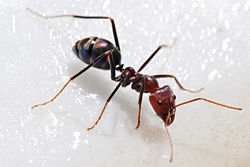 Meat ant (Iridomyrmex purpureus) feeding on honey
| ||||||||||||||
| Scientific classification | ||||||||||||||
| ||||||||||||||
|
Ants are insects of the family Formicidae. They, along with the related families of wasps and bees, belong to the order Hymenoptera. Ants are the one of the world's most successful and diverse animal families, with more than 12,000 species. They are eusocial and known for their highly organized colonies and nests, which sometimes consist of millions of individuals. Individuals are divided into sub-fertile, and more commonly sterile, females ("workers"), fertile males ("drones"), and fertile females ("queens"). Colonies can occupy and use a wide area of land to support themselves. Ant colonies are sometimes described as superorganisms because the colony appears to operate as a unified entity.
Ants are found on almost every landmass on Earth. The only places lacking indigenous ant species are Antarctica, Greenland, Iceland, parts of Polynesia, the Hawaiian Islands, and some other remote islands. When all their individual contributions are added up, they may constitute up to 15 to 25 percent of the total terrestrial animal biomass. (Jones 2007, Krushelnycky 2005, Schultz 2000).
Termites, sometimes called white ants, are not closely related to ants, although they have similar social structures. Velvet ants, although resembling large ants, are wingless female wasps.
Evolution
The Formicidae family belongs to the order Hymenoptera, which also includes sawflies, bees and wasps. Ants are a lineage derived from within the vespoid wasps. Phylogenetic analysis indicates that ants evolved from vespoids in the mid-Cretaceous period about 120 to 170 million years ago. After the rise of angiosperms about 100 million years ago, they increased in diversity and assumed ecological dominance about 60 million years ago. Several fossils from the Cretaceous are intermediate in form between wasps and ants, establishing further evidence for wasp ancestry. Like other Hymenoptera, the genetic system found in ants is haplodiploidy (Grimbaldi 2000, Moreau 2007, Wilson 2005).
In 1966 Edward O. Wilson, who is considered to be one of the world's leading experts and researchers on ants, obtained the first amber fossil remains of an ant (Sphecomyrma freyi) from the Cretaceous era. The specimen was trapped in amber from New Jersey that was more than 80 million years old. This species provides the clearest evidence of a link between modern ants and non-social wasps. Cretaceous ants shared both wasp-like and modern ant-like characteristics (Wilson 1967).
During the Cretaceous era, representatives of only a few species of primitive ants ranged widely on what was the super-continent Laurasia (the northern hemisphere). They were scarce in comparison to other insects (about only 1%). The ants became dominant in an adaptive radiation at the beginning of the Tertiary Period. Of the species extant in the Cretaceous and Eocene eras, only 1 of about 10 genera is now extinct. 56 percent of the genera represented on the Baltic amber fossils (early Oligocene), and 96 percent of the genera represented in the Dominican amber fossils (apparently early Miocene) still survive today (Grimbaldi 2000).
Morphology
Ants are distinguished from other insects by the following traits: elbowed antennae; the presence of a metapleural gland; a strongly constricted second abdominal segment forming a distinct node-like petiole, a narrow waist between their mesosoma (thorax plus the first abdominal segment, which is fused to it) and gaster (abdomen less the abdominal segments in the petiole). The petiole can be formed by one or two nodes (only the second, or the second and third abdominal segments can form it).
Ant bodies, like those of other insects, have an exoskeleton, meaning their bodies are externally covered in a protective casing, as opposed to the internal skeletal framework of humans and other vertebrates. Ants do not have lungs. Oxygen passes through tiny valves, the spiracles, in their exoskeleton — the same holes through which carbon dioxide leaves their body. They have a primative heart and their blood is colorless, rather than red. Their nervous system is much like a human spinal cord in that it is a continuous cord, the ventral nerve cord, from head to rear with branches into each extremity.
The three main divisions of the ant body are the head, the thorax, and the metasoma or gaster.
The head of an ant has many important parts. Ant eyes include the compound eyes, similar to fly eyes: numerous tiny lenses attached together which enables them to see movement very well. They also have three small ocelli on the top of the head, which detect light and dark. Most ants have poor to mediocre eyesight; some are blind altogether. A few have exceptional vision though, such as the bulldog ants (Myrmecia species) ofAustralia. Also attached to the head of an ant are two antennae ("feelers"). The antennae are special organs that help ants detect chemicals, including those used in communication, as well as a sense of touch. Ants release pheromones to communicate with each other and the antennae pick up these chemical signals. The head also has two strong jaws, the mandibles, which are used to carry food, manipulate objects, construct nests, and for defense. In some species there is also a small pocket inside the mouth to hold food for passing to others.
The thorax of the ant is where the six legs are attached. At the end of each leg is a hooked claw that helps ants climb and hang onto things. Most queens and male ants have wings, which they drop after the nuptial flight. The wing scars are then visible, a distinguishing feature of queens. Wingless queens (ergatoids) and males can also occur.
The metasoma (the "abdomen") of the ant houses many of the important internal organs. These include the crop, where food is stored for the ant's own use or to bring back to the colony; the stomach, where food is digested for the ant's own use; and the reproductive organs. Many species of ants have poison glands and stingers used for subduing prey and defending their nests.
Development
The life of an ant starts with an egg. If the egg is fertilized, the ant will be female (diploid); if not, it will be male (haploid). Ants are holometabolous, and develop by complete metamorphosis, passing through larval and pupal stages (with the pupae being exarate) before they become adults. The larval stage is particularly helpless — for instance it lacks legs entirely – and cannot care for itself. The difference between queens and workers (which are both female), and between different castes of workers when they exist, is determined by the feeding in the larval stage. Food is given to the larvae by a process called trophallaxis in which an ant regurgitates food previously held in its crop for communal storage. This is also how adults distribute food amongst themselves. Larvae and pupae need to be kept at fairly constant temperatures to ensure proper development, and so are often moved around the various brood chambers within the colony.
A new worker spends the first few days of its adult life caring for the queen and young. After that it graduates to digging and other nest work, and then to foraging and defense of the nest. These changes are fairly abrupt and define what are called temporal castes. One theory of why this occurs is because foraging has a high death rate, so ants only participate in it when they are older and closer to death anyway. In a few ants there are also physical castes — workers come in a spectrum of sizes, called minor, median, and major workers, the latter beginning foraging sooner. Often the larger ants will have disproportionately larger heads, and correspondingly stronger mandibles. Such individuals are sometimes called "soldier" ants because their stronger mandibles make them more effective in fighting other creatures, although they are still in fact worker ants and their "duties" typically do not vary greatly from the minor or median workers. In a few species the median workers have disappeared, creating a sharp divide and clear physical difference between the minors and majors.
Some ants, called honeypot ants, have special workers called repletes who simply store food for the rest of the colony, generally becoming immobile with greatly enlarged abdomens. In hot, dry places, even deserts, in Africa, North America, and Australia where they live, they are considered by some people to be a great delicacy.
Most of the common ant species breed in the same way. Only the queen and breeding females have the ability to mate. Contrary to popular belief, some ant nests have multiple queens. The male ants, called drones, along with the breeding females emerge from pupation with wings (although some species, like army ants, do not produce winged queens), and do nothing throughout their life except eat and mate. At this time, all breeding ants, excluding the queen, are carried outside where other colonies of the same species are doing the same. Then, all the winged breeding ants take flight. Mating occurs in flight and the males die shortly afterward. The females that survive land and seek a suitable place to begin a colony. There, they break off their own wings and begin to lay eggs, which they care for. Sperm obtained during their nuptial flight is stored and used to fertilize all future eggs produced. The first workers to hatch are weak and smaller than later workers, but they begin to serve the colony immediately. They enlarge the nest, forage for food and care for the other eggs. This is how most new colonies start. A few species that have multiple queens can start a new colony as a queen from the old nest takes a number of workers to a new site and founds a colony there.
Ant colonies can be long-lived. The queens themselves can live for up to 30 years, while workers live from 1 to 3 years. Males, however, are more transitory, surviving only a few weeks (Gordon 1999)
Ants living in seasonal climates survive the winter by going into a state of dormancy or inactivity. The forms of inactivity are varied and some temperate species have larvae that go into diapause while in others the adults alone pass the winter in a state of reduced activity (Wilson 1971).
Behaviour and ecology
Communication
Ant communication is accomplished primarily through chemicals called pheromones. Because most ants spend their time in direct contact with the ground, these chemical messages are more developed than in other hymenopterans. So for instance, when a forager finds food, she will leave a pheromone trail along the ground on her way home. In a short time other ants will follow this pheromone trail. Home is often located through the use of remembered landmarks and the position of the sun as detected with compound eyes and also by means of special sky polarization-detecting fibers within the eyes (Fukushi 2001). Returning home, they reinforce the same trail which in turn attracts more ants until the food is exhausted, after which the trail scent slowly dissipates. This behavior helps ants adapt to changes in their environment. When an established path to a food source is blocked by a new obstacle, the foragers leave the path to explore new routes. If successful, the returning ant leaves a new trail marking the shortest route. Since each ant prefers to follow a path richer in pheromone rather than poorer, the resulting route is also the shortest available.
Ants make use of pheromones for other purposes as well. A crushed ant, for example, will emit an alarm pheromone which in high concentration sends nearby ants into an attack frenzy; and in lower concentration, merely attracts them. To confuse their enemies several ant species even employ "propaganda pheromones", which cause their enemies to fight amongst themselves (Wilson 1971) Like other insects, ants smell with their antennae, which are long and thin. These are fairly mobile, having a distinct elbow joint after an elongated first segment; and since they come in pairs—rather like binocular vision or stereophonic sound equipment—they provide information about direction as well as intensity. Pheromones are also exchanged as compounds mixed with food and passed in trophallaxis, giving the ants information about one another's health and nutrition. Ants can also detect what task group (e.g. foraging or nest maintenance) to which other ants belong. Of special note, the queen produces a certain pheromone without which the workers would begin raising new queens.
Some ants produce sounds by their the gaster segments or mandibles together. Ants can detect sound vibrations that travel through the ground or other surfaces, but it is not certain if they can hear sounds that travel through the air. Sound messages are used to communicate information on food sources and dangers. In one experiment ants trapped underground sent out vibrations and were rescued by ants on the surface who dug down to them (Milius 200).
Defense
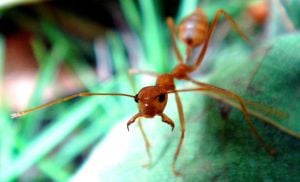
Ants attack others and defend themselves by biting and in many species, stinging, often injecting chemicals like formic acid. Bullet ants (the genus Paraponera), found in Central and South America, are considered to have the most painful sting among insects, although these are usually non-fatal. They are given the highest rating on the Schmidt Sting Pain Index. Jack jumper ants, Myrmecia pilosula, found in Australia have stings that cause fatality to a small number of people in the population, and cause hospitalizations each year (Clarke 1986). A vaccine based on use of the venom extract to develop immunity has been developed (Brown 2005).
Some ants of the genus Odontomachus are equipped with mandibles called trap-jaws. This snap-jaw mechanism, or catapult mechanism, is possible because energy is stored in the large closing muscles. The blow is incredibly fast, about 0.5 ms in the genus Mystrium. Before the strike, the mandibles open wide and are locked in the open position by the labrum, which functions as a latch. The attack is triggered by stimulation of sensory hairs at the side of the mandibles. The mandibles are also able to function as a tool for more finely adjusted tasks. Two similar groups are Odontomachus and Dacetini - examples of convergent evolution.
Apart from defense against larger threats, ants also need to defend their colonies against disease organisms. Some ant workers' role is to maintain the hygiene of the colony and their activities include undertaking or necrophory, the transport of dead nest-mates.[1] Oleic acid is identified as one compound released by dead ants that triggers undertaking behaviour in Atta mexicana.[2]
The nests are also protected from physical threats such as flooding by elaborate structures at the entrance or special chambers for escaping from flooding. Some arboreal species that live in plant hollows (Phytotelmata) also have behavioural responses to flooding, where the workers drink the water and excrete it outside the nest.[3]
Nest construction
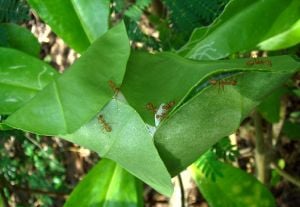
While some ants form complex nests and galleries, other species are nomadic and do not build permanent structures. Various species may form subterranean nests or build them on trees. Nests can be found in the ground with craters or mounds around the entrance, under stones or logs, in logs, hollow stems, even acorns. The materials used for construction include soil and plant matter,[4] and they are highly selective of the nest site; Temnothorax albipennis will avoid sites with dead ants as these may be indicators of pests or disease. They are also quick to abandon established nest sites at the first sign of these threats.[5]
Some of the more advanced ants are the army ants and driver ants, from South America and Africa respectively. Unlike most species which have permanent nests, army and driver ants do not form permanent nests, but instead alternate between nomadic stages and stages where the workers form a temporary nest (bivouac) out of their own bodies. Colonies reproduce either through nuptial flights as described above, or by fission, where a group of workers simply dig a new hole and raise new queens. Colony members are distinguished by smell, and other intruders are usually attacked.
Weaver ants (Oecophylla) build nests in trees by attaching leaves together, first pulling them together with bridges of workers and then sewing them together by pressing silk-producing larvae against them in alternation.
Food cultivation
Leafcutter ants (Atta and Acromyrmex) feed exclusively on a special fungus that lives only within their colonies. They continually collect leaves which they cut into tiny pieces for the fungus to grow on. There are different sized castes specially suited to finer and finer tasks of cutting and chewing the leaves and tending to the garden. Leaf cutter ants are sensitive enough to adapt to the fungi's reaction to different plant material, apparently detecting chemical signals from the fungus. If a particular type of leaf is toxic to the fungus the colony will no longer collect it. The ants grow the fungus because it produces special structures called gongylidia which are fed on by the ants. They create antibiotics on their exterior surfaces with the aid of symbiotic bacteria, and subsist entirely on this farming of the fungus.
Desert ants Cataglyphis fortis make use of visual landmarks in combination with other cues to navigate.[6]
In the absence of visual landmarks, Sahara desert ants have been shown to navigate by keeping track of direction as well as distance travelled, like an internal pedometer that keeps tracks of how many steps they take, and use this information to find the shortest routes back to their nests.[7]
Locomotion
Worker ants generally do not grow wings and reproductive females remove theirs after their mating flights in order to begin their colonies. Therefore, unlike their wasp ancestors, most ants travel by walking.
Some species of ants sometimes form chains to bridge gaps, whether that be over water, underground, or through spaces in arboreal paths. Some species also form floating rafts that help them survive floods. They may also have a role in colonization of islands.[8]
Some ants are even capable of leaping. A particularly notable species is Jerdon's jumping ant, Harpegnathos saltator. This is achieved by synchronized action of the mid and hind pair of legs.[9]
Polyrhachis sokolova, a species of ant found in Australian mangrove swamps, can swim and lives in nests that are submerged underwater. They make use of trapped pockets of air in the submerged nests.[10]
There are several species of gliding ant including Cephalotes atratus. In fact this may be a common trait among most arboreal ants. Ants with this ability are able to direct the direction of their descent while falling.[11]
Ant cooperation and competition
Not all ants have the same kind of societies. The Australian bulldog ants are among the biggest and most primitive of ants. The individual hunts alone, using its large eyes instead of its chemical senses to find prey. Like all ants they are social, but their social behavior is poorly developed compared to more advanced species. An Australian bulldog ant, Myrmecia pilosula, has only a single pair of chromosomes and males have just one chromosome as they are haploid.
Some species of ants are known for attacking and taking over the colonies of other ant species. Others are less expansionist but nonetheless just as aggressive; they attack colonies to steal eggs or larvae, which they either eat or raise as workers/slaves. Some ants, such as the Amazon ants, are incapable of feeding themselves, and must rely on captured worker ants to care for them. In some cases ant colonies may have other species of ants or termites within the same nest.[12]
The pavement ant is famous for its urge to increase its territory. In early spring, colonies attempt to conquer new areas and often attack the nearest enemy colony. These result in huge sidewalk battles, sometimes leaving thousands of ants dead. Because of their aggressive nature, they often invade and colonize seemingly impenetrable areas.
Ants identify kin and nestmates through their scents, a hydrocarbon-laced secretion that coats their exoskeletons. If an ant is separated from its original colony, it will eventually lose the colony scent. Any ant that enters a colony with a different scent than that of the colony will be attacked.[13] (See also Kin selection)
Diversity
| Region | Number of species [4] |
|---|---|
| Neotropics | 2162 |
| Nearctic | 580 |
| Europe | 180 |
| Africa | 2500 |
| Asia | 2080 |
| Melanesia | 275 |
| Australia | 985 |
| Polynesia | 42 |
There is a great diversity among ants and their behaviors. They range in size from 2 to about 25 mm (about 0.08 to 1 inch). Their color may vary; most are red or black, but other colors can also be seen, including some tropical groups with a metallic luster. (See also ant genera). Numerous species of ant continue to be added in present times and taxonomic studies continue to resolve the classification and systematics of ants. Online databases of ant species include AntBase and the Hymenoptera Name Server.[14]
Ants have been used as indicator species in biodiversity studies.[15][16]
Relationships with other species
Ants associate with a wide range of species in many ways. They form mutualisms with other insects, plants, and fungi. They parasitize each other. They are preyed upon by many animals and even certain fungi. Because their nests are such hospitable places, many species of arthropods sneak in and integrate themselves in various ways to the ant's daily lives.
Aphids secrete a sweet liquid called honeydew which they exude in the process of feeding from plants. The sugars can provide a high-energy food source, which many ant species collect. In some cases the aphids secrete the honeydew specifically in response to the ants tapping them with their antennas. The ants in turn keep predators away and will move the aphids around to better feeding locations. Upon migrating to a new area, many colonies will take new aphids with them, to ensure that they have a supply of honeydew in the new area. Ants also tend mealybugs to harvest their honeydew. Mealybugs can become a serious pest of pineapple if ants are present to protect mealybugs from natural enemies.[17][18]
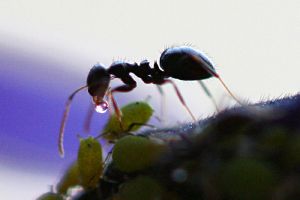
Myrmecophilous (ant-loving) caterpillars of the family Lycaenidae (e.g., blues, coppers, or hairstreaks) are herded by the ants, led to feeding areas in the daytime, and brought inside the ants' nest at night. The caterpillars have a gland which secretes honeydew when the ants massage them. Some caterpillars are known to produce vibrations and sounds that are sensed by the ants.[19] Some caterpillars have evolved from being ant-loving to ant-eating and these myrmecophagous caterpillars secrete a pheromone which makes the ants think that the caterpillar's larva is one of their own. The larva will then be taken into the ants' nest where it can feed on the ant larvae.
Fungus-growing ants that make up the tribe attini, including leafcutter ants, actively cultivate certain species of fungus in the Leucoagaricus or Leucocoprinus genera of the Agaricaceae family. In this ant-fungus mutualism, both species depend on each other for survival. The ant Allomerus decemarticulatus has evolved a tripartite association with their host plant Hirtella physophora (Chrysobalanaceae), and a sticky fungus which is used to trap their insect prey.[20]
Lemon ants make devil's gardens by selectively killing surrounding plants and leaving a pure patch of lemon ant trees Duroia hirsuta.[21] Many trees have extrafloral nectaries that provide food for ants and the ants in turn protect the plant from herbivorous insects. Some species like the bullhorn acacia, Acacia cornigera, in Central America have hollow thorns that serve to house colonies of stinging ants, Pseudomyrmex ferruginea, that defend the tree against insects, browsing mammals, and epiphytic vines. In return, the ants obtain food from protein-lipid Beltian bodies. Another example of this type of ectosymbiosis comes from the Macaranga tree which have stems adapted to house colonies of Crematogaster ants. Many tropical tree species have seeds that are dispersed by ants.[22]
Flies in the Old World genus Bengalia (Calliphoridae) are kleptoparasites and predators on ants and often snatch prey or brood from the adult ants.[23] Wingless and legless females of the Malaysian phorid fly Vestigipoda myrmolarvoidea live in the nests of ants of the genus Aenictus and are cared for by the ants.[23]
Many species of birds show a peculiar behaviour called anting that is as yet not fully understood. Here birds may rest on ant nests or pick and drop ants onto their wings and feathers, presumably to rid themselves of ectoparasites.
A fungus, Cordyceps, infects ants, causing them to climb up plants and sink their mandibles into the plant tissue. The fungus kills and engulfs the ant and produces its fruiting body. It appears that the fungus alters the behavior of the ant and uses the ant to help disperse its spores.[24]
Some South American frogs in the genus Dendrobates feed primarily on ants and the toxins on their skin may be derived from the ants.[25]
Brown bears (Ursus arctos) have been found to feed on ants, with as much as 12%, 16%, and 4% of their fecal volume in spring, summer, and autumn, respectively being made up of ants.[26]
Many species of mammals such as anteaters, pangolins and several marsupial species in Australia have special adaptations for living on a primary diet of ants. These adaptations include long sticky tongues to pick the ants and strong claws to break into the ant nests. Some South American birds such as the antpittas are also ant predators.
Humans and ants
Ants are useful for clearing out insect pests and aerating the soil. The use of weaver ants in citrus cultivation in southern China is one of the oldest known uses of biological control.[4] On the other hand, they can become annoyances when they invade homes, yards, gardens and fields. Carpenter ants damage wood by hollowing it out for nesting.
In some parts of the world large ants, especially army ants, are said to be used as sutures by pressing the wound together and applying ants along it. The ant in defensive attitude seizes the edges in its mandibles and locks in place. The body is then cut off and the head and mandibles can remain in place, closing the wound.[27]
Some species, called killer ants, have a tendency to attack much larger animals during foraging or in defending their nests. Attacks on humans are rare, but the stings and bites can be quite painful and in large enough numbers can be disabling.
The Masai of Africa had an abiding respect for the Siafu ants, voracious predators that consume a large amount of insects and are welcomed for the benefit they bring to farmers, as they will eliminate all pests from a crop and quickly move on.
In South Africa, ants are used to help harvest rooibos, Aspalathus linearis, the small seeds of which are used to make a herbal tea.[28]
Ants as food
Ants and their larvae are eaten in different parts of the world. The eggs of two species of ants are the basis for the dish in Mexico known as "escamoles"(see cooking video). They are considered a form of insect caviar and can sell as high as $40 USD per pound because they are seasonal and hard to find. In the Colombian department of Santander, hormigas culonas (lit.: "fatass ants") Atta laevigata are toasted alive and eaten.[29] This tradition has come down from the native Guanes. In parts of Thailand, ants are prepared and eaten in various ways. Khorat ant eggs and diced flying ants are eaten as an appetizer. Weaver ant eggs and larvae as well as the ants themselves may be used in a Thai salad, yum (ยำ), in a dish called yum khai mod daeng (ยำไข่มดแดง) or red ant egg salad, a dish that comes from the Issan or north-eastern region of Thailand. Weaver ant queens may also be eaten live, at the time of nest initiation.
Charles Thomas Bingham notes that in parts of India, and throughout Burma and Siam, a paste of the green weaver ant, Oecophylla smaragdina, is served as a condiment with curry. Saville Kent, in the Naturalist in Australia wrote "Beauty, in the case of the green ant, is more than skin-deep. Their attractive, almost sweetmeat-like translucency possibly invited the first essays at their consumption by the human species." Mashed up in water, after the manner of lemon squash, "these ants form a pleasant acid drink which is held in high favor by the natives of North Queensland, and is even appreciated by many European palates."[30]
John Muir, in his First Summer in the Sierra notes that the Digger Indians of California ate the tickly acid gasters of the large jet-black carpenter ants. The Mexican Indians eat the replete workers, or living honey-pots, of the honey ant (Myrmecocystus).[30]
Ants as pests
Modern society considers the ant a pest,[31] and due to the adaptive nature of ant colonies, eliminating them is nearly impossible. Pest control with regard to ants is more a matter of controlling local populations than eliminating an entire colony. Attempts to control ant populations of any kind are temporary solutions.
Typical ants that are classified as pests include pavement ants (otherwise known as the sugar ant), Pharaoh ants, carpenter ants, Argentine ants, and the red imported fire ant. Control of species populations are usually done with bait insecticides, which are either in the form of small granules, or as a sticky liquid that is gathered by the ants as food and then brought back to the nest where the poison is inadvertently spread to other members of the brood — a system that can severely reduce the numbers in a colony if used properly. Boric acid and borax are often used as insecticides that are relatively safe for humans. With the recent insurgence of the red imported fire ant, a tactic called broadcast baiting has been employed, by which the substance (usually a granule bait designed specifically for fire ants) is spread across a large area, such as a lawn, in order to control populations. Nests may be destroyed by tracing the ants' trails back to the nest, then pouring boiling water into it to kill the queen. This works in about 60% of the mounds and needs about 14 litres (3 gallons) per mound.[32]
Ants that tend other insects can indirectly cause pest infestations. Many homopteran insects that are considered as horticultural pests are controlled by the use of grease rings on the trunks of the trees. These rings cut off the routes for ants and make the pest species vulnerable to parasites and predators.
Studying ants
Myrmecologists study ants both in the laboratory and in their natural conditions using a number of tools and techniques. Ants are model organisms for the study of sociobiology and the testing of hypotheses such as those based on the theories of kin selection or evolutionarily stable strategies. Ant colonies can be reared or temporarily maintained in specially constructed glass frames for study purposes.[33] For certain kinds of studies it is necessary to identify specific individual ants through the study period and this is achieved by use of colour marking techniques.[34] The use of endoscopes to observe ants inside their nest tunnels is another technique that has been used in the field.
Ant inspired technology
The successful techniques used by ant colonies has been widely studied especially in computer science and robotics to produce distributed and fault-tolerant systems for solving problems. This area of biomimetics has led to studies of ant locomotion, search engines which make use of foraging trails and fault tolerant storage and networking algorithms.[35] (See also Langton's ant and ant colony optimization.)
Ants in culture
Ants have often been used in fables and children's stories to represent industriousness and cooperative effort, as well as aggressiveness and vindictiveness. They are also mentioned in religious texts.[36][37] In parts of Africa, ants are the messengers of the gods. Ant bites are often said to have curative properties. The sting of some species of Pseudomyrmex is claimed to give fever relief.[38] Some Native American religions, such as Hopi mythology, recognize ants as the very first animals. Others use ant bites in initiation ceremonies as a test of endurance.[39][40]
The Japanese word for ant, ari, is represented by an ideograph formed of the character for insect combined with the character signifying moral rectitude, propriety (giri). So the Chinese character could possibly be read as The Propriety-Insect. Its actual etymology is likely to be different however.[41]
Ant society has always fascinated humans and has been written about both humorously and seriously by writers. Mark Twain wrote about ants in his A Tramp Abroad. In more recent times, animated cartoons and 3D animated movies featuring ants have been produced include Antz, A Bug's Life, The Ant Bully, The Ant and the Aardvark , Atom Ant, and there is a comic book superhero called Ant-Man.
From the late 1950's through the late 1970's, ant farms were popular educational children's toys in the United States. In the early 1990's, the video game SimAnt, which simulated an ant colony, achieved minor success in the gaming world.
Ants are also quite popular as the inspiration for many science-fiction races, such as the Formics of Ender's Game or the Bugs of Starship Troopers. These races are often referenced as having a hive mind, a common misconception about ant colonies, and benefit from uncommon unity of focus and a willingness for the individual to give their life for the good of the hive. In strategy games, ant-based species often benefit from increased production rates due to their single-minded focus, such as the Klackons in the Master of Orion series of games.
ReferencesISBN links support NWE through referral fees
- Brown, S. et al. 2005. "Efficacy of ant venom immunotherapy and whole body extracts". Journal of Allergy and Clinical Immunology. Volume 116.
- Clark, P. 1986. "The natural history of sensitivity to jack jumper ants (hymenoptera:formicidae:Myrmecia pilosula) in Tasmania". Medical Journal of Australia. Volume 145.
- Fukushi, T. 2001. "Homing in wood ants, Formica japonica: use of the skyline panorama". The Journal of Ecperimental Biology. Accessed October 5, 2007.
- Gordon, D. 1999. Ants at Work. New York: The Free Press. ISBN 0684857332
- Grimaldi, D. and Agosti, D. 2000. "A formicine in New Jersey Cretaceous amber (Hymenoptera: Formicidae) and early evolution of the ants". Proceedings of the National Academy of Sciences of the United States of America. Accessed September 30, 2007.
- Hoyt, E. 1996. The Earth Dwellers: Adventures in the Land of Ants. New York: Simon & Schuster. ISBN 0684810867
- Jones, A. 2007. "Did You Know?". Nationalgeographic.com. Accessed September 30, 2007.
- Krushelnycky, P. 2005. "Hawaii Ants" Antweb.org Accessed September 30, 2007.
- Milius, S. 2000. "When Ants Squeak". Science News Online. Accessed October 5, 2007.
- Moreau, C. et al. 2006. "Phylogeny of the Ants: Diversification in the Age of Angiosperms". Science. Accessed September 30, 2007.
- Schultz, T. 2000. "In search of ant ancestors". Proceedings of the National Academy of Sciences of the United States of America. Accessed September 30, 2007.
- Wilson, E. et al. 1967. "The First Mesozoic Ants" Science. Accessed September 30, 2007.
- Wilson, E. 1971. The Insect Societies. Cambridge, Massachusetts: The Belknap Press of Harvard University Press. ISBN 0674454901
- Wilson, E. and Holldobler, H. 2005. "The rise of the ants: A phylogenetic and ecological explanation". Proceedings of the National Academy of Sciences of the United States of America. Accessed September 30, 2007.
- ↑ Julian G.E., Cahan S. (1999). Undertaking specialization in the desert leaf-cutter ant Acromyrmex versicolor.. Anim. Behav. 58 (2): 437–442.
- ↑ Germán Octavio López-riquelme, Edi A. Malo, Leopoldo Cruz-lópez, María Luisa Fanjul-moles (2006). Antennal olfactory sensitivity in response to task-related odours of three castes of the ant Atta mexicana (hymenoptera: formicidae). Physiological Entomology 31 (4): 353–360.
- ↑ Maschwitz, U. (2000). Communal peeing: a new mode of flood control in ants.. Naturwissenschaften 87 (12): 563–565.
- ↑ 4.0 4.1 4.2 B. Hölldobler & E. O. Wilson. The Ants. Harvard University Press.
- ↑ Franks, N.R. (2005). Tomb evaders: house-hunting hygiene in ants. Biol. Lett. 1 (2): 190–192.
- ↑ Susanne Åkesson & Rüdiger Wehner (2002). Visual navigation in desert ants Cataglyphis fortis: are snapshots coupled to a celestial system of reference?. Journal of Experimental Biology 205: 1971–1978.
- ↑ S. Sommer & R. Wehner (2004). The ant's estimation of distance travelled: experiments with desert ants, Cataglyphis fortis. J. Comp. Physiol. A Neuroethol. Sens. Neural Behav. Physiol. 190 (1): 1–6.
- ↑ Morrison, L. W. (1998) A Review of Bahamian Ant (Hymenoptera: Formicidae) Biogeography. Journal of Biogeography. 25(3):561-571
- ↑ C. Baroni Urbani, G. S. Boyan, A. Blarer, J. Billen & T. M. Musthak Ali (1994). A novel mechanism for jumping in the Indian ant Harpegnathos saltator (Jerdon) (Formicidae, Ponerinae). Experientia 50: 63–71.
- ↑ R. E. Clay & A. N. Andersen (1996). Ant fauna of a mangrove community in the Australian seasonal tropics, with particular reference to zonation. Australian Journal of Zoology 44: 521–533.
- ↑ S. P. Yanoviak, R. Dudley & M. Kaspari (2005). Directed aerial descent in canopy ants. Nature 433: 624–626.
- ↑ E. Diehl, L. K. Junqueira & E. Berti-Filho (2005). Ant and termite mound coinhabitants in the wetlands of Santo Antonio da Patrulha, Rio Grande do Sul, Brazil. Brazilian Journal of Biology 65 (3): 431–437.
- ↑ Gregg Henderson, John F. Andersen, Joel K. Phillips & Robert L. Jeanne (2005). Internest aggression and identification of possible nestmate discrimination pheromones in polygynous ant Formica montana. Journal of Chemical Ecology 16 (7): 2217–2228.
- ↑ Donat Agosti & N. F. Johnson (eds.) (2005). Antbase.
- ↑ D. Agosti, J. D. Majer, L. E. Alonso & T. R. Schultz (eds.) (2000). Ants: Standard methods for measuring and monitoring biodiversity. Smithsonian Institution Press, 280 pp.
- ↑ Hymenoptera name server. Ohio State University.
- ↑ G. C. Jahn & J. W. Beardsley (1994). "Big-headed ants, Pheidole megacephala: interference with the biological control of gray pineapple mealybugs", in D. F. Williams: Exotic ants: biology, impact, and control of introduced species. Westview Press, Boulder, Colorado, 199–205.
- ↑ G. C. Jahn & J. W. Beardsley (1996). Effects of Pheidole megacephala (Hymenoptera: Formicidae) on survival and dispersal of Dysmicoccus neobrevipes (Homoptera: Pseudococcidae). Journal of Economic Entomology 89: 1124–1129.
- ↑ Philip J. DeVries (1992). Singing caterpillars, ants and symbiosis. Scientific American 267: 76.
- ↑ Alain Dejean, Pascal Jean Solano, Julien Ayroles, Bruno Corbara & Jérôme Orivel (2005). Arboreal ants build traps to capture prey. Nature 434: 973.
- ↑ Frederickson, M. E. and Deborah M. Gordon (2007). The devil to pay: a cost of mutualism with Myrmelachista schumanni ants in ‘devil’s gardens’ is increased herbivory on Duroia hirsuta trees. Proc. R. Soc. B 274: 1117–1123.
- ↑ Frances M. Hanzawa, Andrew J. Beattie & David C. Culver (1988). Directed dispersal: demographic analysis of an ant-seed mutualism. American Naturalist 131 (1): 1–13.
- ↑ 23.0 23.1 J. Sivinski, S. Marshall & Erik Petersson (1999). Kleptoparasitis and phoresy in the Diptera. Florida Entomologist 82 (2): 179–197.
- ↑ Elio Schaechter (2000). Some weird and wonderful fungi. Microbiology Today 27 (3): 116–117.
- ↑ J. P. Caldwell (1996). The evolution of myrmecophagy and its correlates in poison frogs (Family Dendrobatidae). Journal of Zoology 240 (1): 75–101.
- ↑ Jon E. Swenson, Anna Jansson, Raili Riig & Finn Sandegren (1999). Bears and ants: myrmecophagy by brown bears in central Scandinavia. Canadian Journal of Zoology 77 (4): 551–561.
- ↑ F. Gottrup & David Leaper (2004). Wound healing: historical aspects. EWMA Journal 4 (2).
- ↑ David R. Downes and Sarah A. Laird. Innovative Mechanisms for Sharing Benefits of Biodiversity and Related Knowledge.
- ↑ Hormigas culonas. Retrieved 2007-03-14. (Spanish)
- ↑ 30.0 30.1 J. Bequaert (1921). Insects as Food. Natural History.
- ↑ Ants as pests
- ↑ Oklahoma State University. Two step method for Fire Ant control.
- ↑ Kennedy, C. H. Myrmecological technique. [1]
- ↑ Daniel P. Wojcik, Richard J. Burges, Chantal M. Blanton, Dana A. Focks (2000). An Improved and Quantified Technique for Marking Individual Fire Ants (Hymenoptera: Formicidae). The Florida Entomologist 83 (1): 74-78. doi:10.2307/3496231.
- ↑ E. Dicke, A. Byde, D. Cliff & P. Layzell (2004). Proceedings of Biologically Inspired Approaches to Advanced Information Technology: First International Workshop, BioADIT 2004 LNCS 3141: 364–379.
- ↑ Quran 27:18–19.
- ↑ Sahih Bukhari Vol 4, Book 54, Number 536.
- ↑ William L. Balee (2000). Antiquity of Traditional Ethnobiological Knowledge in Amazonia: The Tupi-Guarani Family and Time. Ethnohistory 47 (2): 399–422.
- ↑ N. Cesard, J. Deturche & P. Erikson (2003). "Les Insectes dans les pratiques médicinales et rituelles d’Amazonie indigène", in E. Motte-Florac & J. M. C. Thomas: Les insectes dans la tradition orale. Ethnosciences 5. Paris, Peeters-Selaf, 395–406.
- ↑ D. F. Janssen (2007). EncycloPaideia. A Thematic Poly-Linguistic Dictionary of Male Initiation/Passage Rituals.
- ↑ Lafcadio Hearn (1904). Kwaidan: Japanese stories and studies of strange things.
Credits
New World Encyclopedia writers and editors rewrote and completed the Wikipedia article in accordance with New World Encyclopedia standards. This article abides by terms of the Creative Commons CC-by-sa 3.0 License (CC-by-sa), which may be used and disseminated with proper attribution. Credit is due under the terms of this license that can reference both the New World Encyclopedia contributors and the selfless volunteer contributors of the Wikimedia Foundation. To cite this article click here for a list of acceptable citing formats.The history of earlier contributions by wikipedians is accessible to researchers here:
The history of this article since it was imported to New World Encyclopedia:
Note: Some restrictions may apply to use of individual images which are separately licensed.
